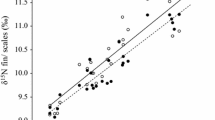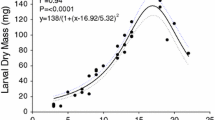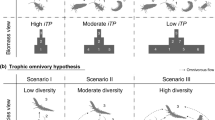Abstract
The net uptake and loss of any element by a living organism can be described as the quotient of the total amount of the element, present in the organism, and its residence time in the organism. Theoretically it can be derived that the residence time τ i , equals V 1−b i /k, in which b, the morphometric coefficient, is related to size and shape of the organism (volume V i ); k, the turnover coefficient, is related to its metabolic activity. The net uptake or excretion, Φ i , of an element then follows from Φ = k C i V b i , C i being the (average, whole animal) concentration of the element.
Residence times, derived from the quotient of body volume (weight) and daily food intake of various animal species of different sizes, show that, independent of animal or element species, the morphometric coefficient and turnover coefficient have values of b = 0.735 and k = 71.4 dm. year-1 respectively. The turnover coefficient may show some variation, related to the metabolic activity of the organism. The value of the morphometric coefficient implies that residence times may vary with body size: in small animals the residence times of the elements may be in the order of several hours, whereas in the largest organisms residence times may be as long as several years.
The uptake of Na, Mg, Cl and P calculated from the above equation (Φ i = k C i V b i ) corresponds very well with data in the literature on the mineral requirements of domestic animals; for Ca the calculated values were lower, for I higher, but they show the same weight-dependence as predicted from the equation. This suggests that the equation may be used tentatively to assess dietary requirements for elements for which up till now no such information exists.
Values derived for the uptake and excretion of various elements by the whole biosphere correspond roughly to those estimated for their oceanic fluxes (from data compiled by Brewer, 1975). This supports the hypothesis that the global turnover of (many) elements is closely related to biological (metabolic) processes.
Similar content being viewed by others
References
Altman, P.L. and D.S. Dittmer (1974). Biological data book III. Ch. X. Nutritional standards (pp. 1450–1458), Mineral requirements (pp. 1458–1465).
Benedict, F.G. (1938). Vital energetics. - Carnegie Inst. Washington Publ. 503, 1–215.
Brewer, P.G. (1975). Minor elements in seawater. In: J.P. Riley and G. Skirrow (eds.), Chemical oceanography I, 415–498. London: Academic Press.
Fonds, M., T. Zohary and A. Barnes (1981). The relation between daily food intake and growth of the pacific mangrowe prawn Palaemon elegans Ratthke, both from the Gulf of Elat. Kieler Meeresforsch. Sonderh. 5, 501–510.
Kleiber, M. (1961). The fire of life. New York: Wiley. 453 p.
MacKenzie, F.T. (1975). Sedimentary cycling and the evolution of seawater. In: J.P. Riley and G. Skirrow (eds.), Chemical Oceanography, I, 309–365. London: Academic Press.
Polikarpov, G.G. (1966). Radioecology of aquatic organisms. Amsterdam: North Holland. 314 p.
Sidwell, V.D., D.H. Buzzel, P.R. Foncannon and A.L. Smith (1977). Composition of the edible portion of raw (fresh or frozen) crustaceans, finfish and molluscs. II. Macro elements: sodium, potassium, chlorine, calcium, phosphorus and magnesium. Marine Fisheries Review 39 (1), 1–11.
Sidwell, V.D., A.L. Lomis, K.J. Lomis, P.R. Foncannon and D.H. Buzzel (1978). Composition of the edible portion of raw (fresh or frozen) crustaceans, finfish and molluscs III. Micro elements Marine Fisheries Review 40 (9), 1–21.
Spaargaren, D.H. and H.J. Ceccaldi (1982). Some relations between the elementary chemical composition of (marine) organisms and that of sea water. Oceanologia acta (in prep.).
Vinogradov, A.P. (1953). The elementary composition of marine organisms. New Havens: Yale University.
Yamamoto, T., Y. Otsuka, M. Koazaki and K. Okamoto (1978). A method of data analyis on the distribution of chemical elements in the biosphere. In: J. Albiges (ed.), Analytical techniques in environmental chemistry, 401–405. London: Pergamon Press.
Author information
Authors and Affiliations
Rights and permissions
About this article
Cite this article
Spaargaren, D.H. Some aspects of element turnover in living organisms. Acta Biotheor 32, 13–28 (1983). https://doi.org/10.1007/BF00047972
Received:
Issue Date:
DOI: https://doi.org/10.1007/BF00047972




